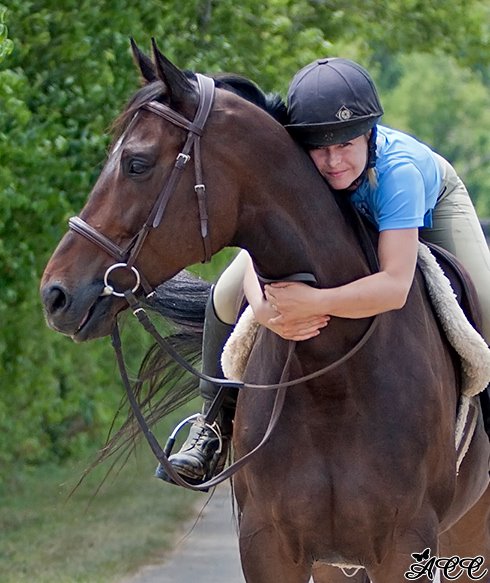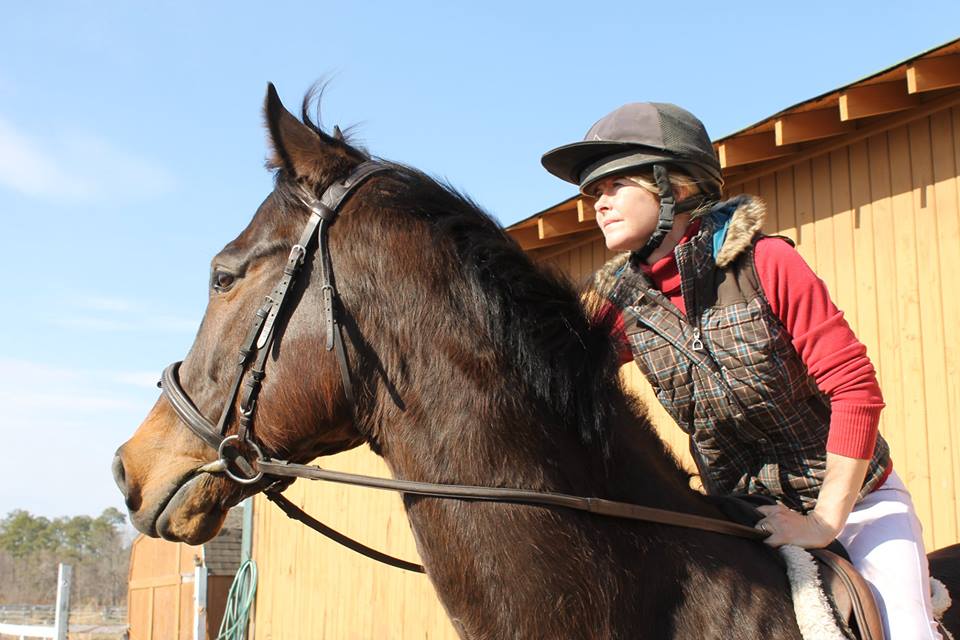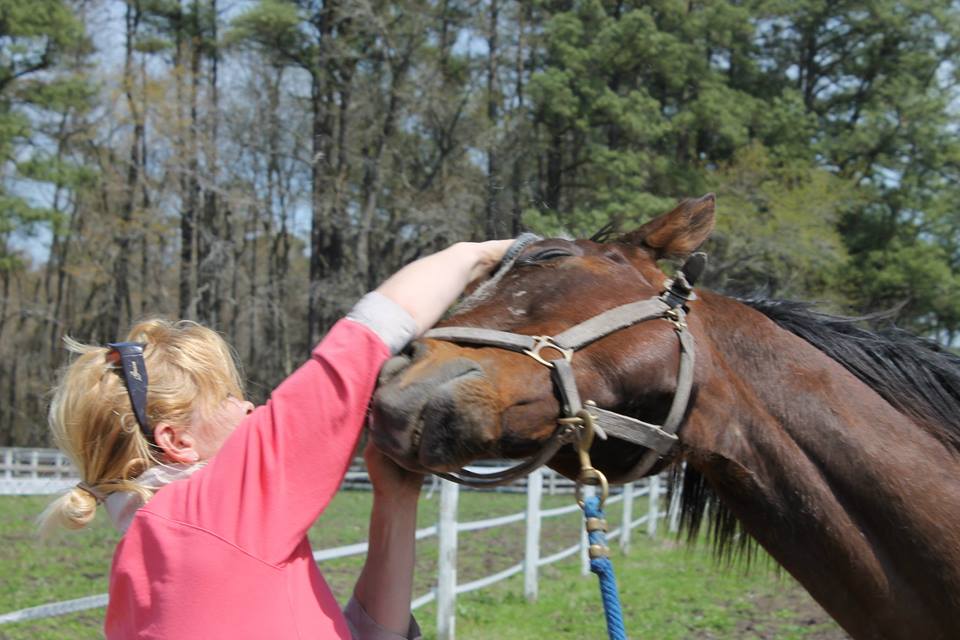Lisa Molloy estimates she has re-homed 700 ex-racehorse Thoroughbreds, while working for five charities over the years.
And of those adoptions, perhaps only five horses each year did not work out.
It’s not magic, she says. The ever-sensible horse trainer from England advises that the best approach to matching a prospective adopter with a deserving horse is practicality.
In this week’s Clubhouse Q&A, Molloy, the executive director of ReRun, Inc.’s Thoroughbred adoption program offers tips and advice on navigating the ins and outs of horse adoptions.
Q: How does a prospective adopter remain practical when looking to buy a beautiful Thoroughbred?
The first thing I tell them is to be realistic about their limitations and the horse’s limitations.
For example, if someone really thinks they want to show and do jumping, and they’re told by the adoption agency that the horse is only good for trail horse, at best, it’s not going to work.
Don’t just take the horse because he has a pretty face and nice pictures. If you do, you both could be out of luck. The horse could be faced with a discipline he can’t do, and the adopter may have a horse who can’t fulfill the requirements they have.
Q: Another major factor is the experience level of the rider.
Typically I don’t adopt horses out to beginners or first-time horse owners, or to children.
For beginners, there’s no point putting a green horse with a green rider. It’s not going to be beneficial. If people still want to go the adoption/rescue route, there are many adoptions agency that deal in breeds that would be more suitable while they’re learning to ride.
With regards with children, as a mother myself, I have to be conscientious of safety. I just don’t think a 17-hand Thoroughbred who has 70 starts on him, and hasn’t been fully retrained, is a suitable match for a 10-year-old child.
Q: What skillset should a prospective adopter have?
I look for good intermediate-level riders who are perhaps working with a trainer as well.
An intermediate rider has a good foundation on the basics of schooling at the walk, trot, canter, and possibly some basic jumping and dressage; they can ride independent of their hands, where there’s first instinct isn’t to snatch at the face.
With beginner riders, the first instinct, and this is natural, is to pull on the face if the horse starts going faster. With a green-broke racehorse, the only thing this will do is make the horse go faster.
Q: Sometimes the rider isn’t the best judge of his or her riding skills.
I prefer to work with a rider who has a trainer. Often, the trainer gives a different story as to the rider’s abilities, and I’ve found some people, who will try to get a horse without involving their trainer, regret it. If they get the horse and the trainer wounds up detesting the horse, the horse will come back.
Q: You also recommend a prospective adopter do a little studying about key veterinary terms.
Some medical terms will sound really scary, and actually they’re not. For example: condylar fracture. And non-displaced condylar fracture.
This is a fracture to the canon bone, and some can be fixated with screws, and others will heal with stall rest and small-pen turnout. Horses with these injuries can go into anything after they heal.
Years ago, I had a horse that had a condylar repaired on all four legs. And, he carried on running for another 2 years after the last one. He was eventually adopted out, and he did a bit of everything including some low-level jumping.
Another term is sesamoid fractures. These come in varying degrees of severity, so an adopter should look over the X-rays and consult with the charity.
Q: Perhaps X-rays say more than a glamorous photo of the animal on a good day?

A tender moment with her own Thoroughbred makes a beautiful photo. But Molloy warns to look beyond the glamorous pictures when shopping for an OTTB.
Everyone wants to put out pretty pictures of their sale horses and nice videos, but it’s like buying a used car—you clean up the car before you sell it. And with horses, nobody takes a photo of the horse on a real windy, cold day when he’s playing on his way to the field. The photos don’t show the bad days, because their intent is to make you take them. This goes back to being realistic about your abilities as a ride rand a handler.
Q: You also recommend being cognizant of the fact that some adoptive horses are still new to their post-racing jobs.
While the horses are vetted, and we try to do an adequate representation of the horse’s abilities, adopters should consider these horses as green-broke. Some have been walk, trotted, cantered, and trail ridden. But they have loads of experience on the racetrack, and the whole world of retirement riding is new to them.
Q: What do you look for when choosing an adopter?
I consider where the horse will be kept, and make sure it will be a safe and clean environment. And the adopters need to understand the nutritional requirements for keeping a Thoroughbred, as well as the cost of upkeep.
A lot of Thoroughbreds will require front shoes, and that needs to be figured into their pricing.
And this is the thing that always shocks me: People don’t seem to realize how much it costs to keep a 1,200-pound animal.

When an adopter learns to gauge his or her abilities and approaches horse shopping sensibly, the best matches can be found.
Full board with shoes and little else is going to run about $600 month. If you board a horse in the pasture, the price drops to around $200 months. But there are many other costs, for Coggins, de-worming, fluctuations in feed prices, and increased hay usage in winter.
It is far more cost effective to buy a higher-priced, good-quality bag of feed or bale of hay than it is to skimp, and buy hay they won’t eat. If their nutritional requirements are not met they start dropping weight.
And I always recommend adopters have an emergency financial plan. This could be a credit card solely used for veterinary emergencies, or finding a veterinary practice that offers a line of credit. An emergency isn’t always something like colic. The horse could develop an infection and require a vet attend to him all night.
Q: Yet, with all of your sobering advice, you have a terrific success rate adopting horses.
I take the time to find the right home for my horses. I would rather invest more time and money in transitioning the horse, and keep the horse around longer, than throw the horse at the first person who comes along offering money.
We’re supposed to be in the business that the horse comes first over your bottom line. If the horse requires extra time, I’ve always found that it’s better in the long term to keep the horse in the program until the right owner comes along.
Q: At the end of the day, it’s practicality, patience and good adopters that make the day for a retiring racehorse.
The adopters and the horses are what make the program successful. Without the adopters these horses would have no place to go. I’m very thankful for the people who have opened up their homes.
I work seven days a week though all kinds of weather, and believe me, there are times when I feel I could walk away. But then I’ll get a photo from someone who adopted a horse, and that horse might have been difficult, maybe he was one I thought I’d have forever, and I see how happy they are. These stories remind me how great it is when it works out.
Sometimes I think the horses find us more than we find them.





Victoria I hear u.
My TB was a flea bit’n skinny rain rot cut up back leg boy’I had his coat shinning in no time’ put the weight on him he was a beauty’I rode him bare back threw trails and fields’ 100% trust for both of us. And when he left me just 2yrs ago’ I was so heart broken I went an bought another TB.Just wish I read this first.My OC is a wonderful TB’ as long as he is not on trails…..I’ve tried for a whole yr. and again today he just gets so anxious coming back to the barn. Now he is going up for sale’and it will hurt.He will make a wonderful show horse’Barrel racer’Both my TBs where and are kind sweet boy’s not a mean bone in there body. I have a trainer now’ and will be looking for one special trail horse and yes it will be a TB…..
The best horse friend/TB found me. Diva came to our Barn as the Owners intention on the Mare being for her husband to ride. Diva just didn’t mesh well, if u will. I felt bad for her being in the pasture everyday with out a humane/treat bearer….skip beautiful yet so sad lookin. Diva started a handful of races. Was pin fired on all four, then a hunter jumper barn resident, Also used as a brood mare. 7 owners b 4 we met. Did I say how beautiful she was……Liver Bay with the perfect markings…..even her pi fire scares made her look bad to the Bone. I would tell her they were Tattoo’s. We didn’t talk much about them……Diva was a rare TB…..to many things about her to express. I rode Diva with a halter nd lead rope….just me tho….Diva got me…I didn’t her. I was hers……my post is in response to your statement regarding TB’s nd their front feet…..so true. Happy Hoofs Happy Horse…sick feet can cause so much more then Founder ect….. I would like to add my opinion for future TB adopters…KEEP YOUR HORSES PASTURE HIGH ND DRY ND SHADE. In lieu of the above-mentioned…..not Only did my care taker keep her feet wet the noseeums took a toll on her sensitive TB COAT. This is a Breed that needs certain care when a person becomes a TB’s special person. The soul of my Diva was such a blessing in my life. O I have rambled on…..its been 5 years since she left me…..I have had plenty of opportunities…..I can’t settle…Diva is a hard mare to follow. I have been blessed….
Thank you Lisa! Your untiring work is admirable and I, for one, am so happy to know these horses can count on you!
Hello Lisa,
I just want to say that I think your way of deciding how people can adopted any of your retired TB race horses are second to none. Your not only looking out for the person’s best interest but the horse’s best interest too. I believe that is really important no matter how much a person wants a particular horse or how much money they are willing to pay for a horse that you feel isn’t a good match. I have always loved being around horses and back in summer of 1973 I had an opportunity to see Secretariat win his triple crown in NY but I allowed my friends to talk me into going with them to VA Beach for that weekend. To this day I regret that decision. I have always like TB horses but for some reason I never took the time to learn to ride when I was younger. Now that I’m almost 62, I feel my time to learn how to ride so I could go tail and pleasure riding with friends that my days might be over for me. I love all animals and believe in adoption to give animals a second chance. I suggest for you to stay strong with your judgement’s on whom can adopted what horse. I believe in your way with matching any person to a RTB horse is the best way and is second to none.
Rob Davis
And there is a TB for you out there. Just listen and process what you are told about the horse. My first TB was exactly what you do not want a beginner to have. Hot, opinionated and very fiesty. Very much the racehorse that he was. It took me 6 years before I had the skills to ride him.
It is hard to say no to such a beautful animal when it is standing right next to you. But remember to step back and evaluate your skills as a horseman and rider before you say yes.
By being practical you will find the right horse for you. Or the horse will find you.
Whether it’s Thoroughbreds or dogs, the mantra should remain the same – be realistic. Lisa very clearly demonstrates that you can be pragmatic AND a successful rescue partner at the same time.
Thank you ,Lisa Malloy for all you do for our retired racehorses. You go above and beyond. Huge thanks for helping the Tampa horses this meet, you are one in a million.